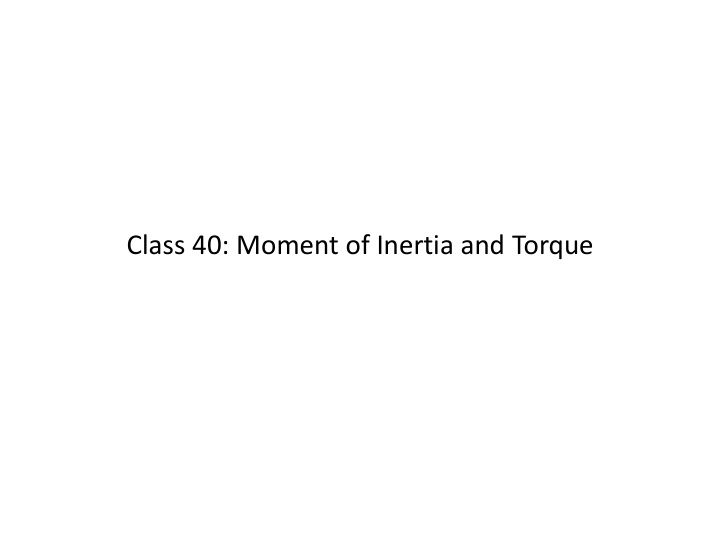



Class 40: Moment of Inertia and Torque
Course Evaluation: 1. Started yesterday Apr 13 th , ends Dec 29 th (Wednesday). 2. Go to http://pa.as.uky.edu/ 3. Click at “UNDERGRADUATES” in the top menu and then choose the first item: Physics & Astronomy Course Evaluations 4. Follow instructions from there. 5. Make sure remember or write down any given key or password. You need this to re-enter the system if you cannot finish the evaluation in one time.
Velocity of Center of mass m v m v i ix i ix dx m v m v m v CM 1 1x 2 2x N Nx i i v CMx dt m m m m M 1 2 N i total i m v m v i iy i iy m v m v m v dy 1 1y 2 2y N Ny CM i i v CMy dt m m m m M 1 2 N i total i m v m v i iz i iz dy m v m v m v CM 1 1z 2 2z N Nz i i v CMz dt m m m m M 1 2 N i total i
Example Before collision: 4kg 2kg 4m/s 5m/s #1 #2 After collision: 4kg 2kg #1 v 1f =? 1m/s #2 1. v 1f =? 2. What is the velocity of the CM before the collision? 3. What is the velocity of the CM after the collision?
Newton’s Second Law for Translational Motion of a Rigid Body d r CM F M a M ext CM d t We can “condense” the rigid body into a particle at the CM. This fictitious particle will follow Newton’s second law of motion with the external forces acting on the rigid body.
projectile motion CM performing Examples
Newton’s Second Law for Translational Motion of a Rigid Body d r CM F M a M ext CM d t We can “condense” the rigid body into a particle at the CM. This fictitious particle will follow Newton’s second law of motion with the external forces acting on the rigid body. F 1 F 2 F 1 M F 2 CM M F 3 F 3 This will give you 3 equations of motion (translational motion).
Example Write down the translational equations of motion for the CM in the following two cases: Rolling without 1. slipping 2. Yo-yo
Rotational Motion In this class we will study only “simple” rotational motion: the axis of rotation is perpendicular to the page. In this simple case, angular velocity and angular acceleration can be considered as vectors along the axis of rotation, perpendicular to the page.
Constant angular acceleration Translational Motion Rotational Motion x v a t v v a t f i f i 1 1 2 2 x x v t a t t t f i i f i i 2 2 2 2 2 2 2 ( ) v v 2a (x x ) f i f i f i f i
Moment of Inertia Moment of inertia to rotational motion is like mass to translational motion. It measures the difficulty or easiness (inertia) in changing the angular velocity. The moment of inertia not only depends on mass (M), but it also depends on the mass distribution about the axis of rotation. So it depends on the shape of the object and the location and orientation of the axis of rotation. 2 I r dm Unit of moment of inertia: kgm 2
Moment of Inertia of Some Common Shapes
Recommend
More recommend